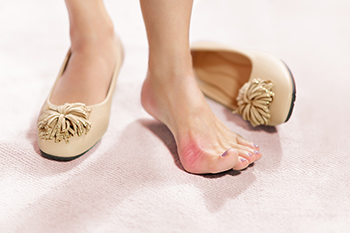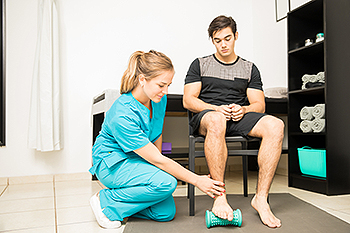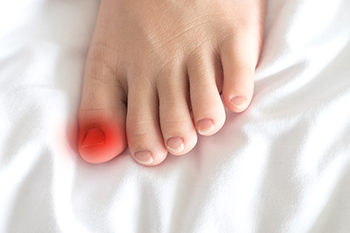

A bunion can develop due to genetic reasons or from wearing shoes that do not have adequate room for the toes to move freely. Additionally, there may be medical reasons why bunions develop, including arthritis, or a weakness of the joint. A bunion is defined as a bony protrusion that forms on the bottom of the joint in the big toe, and it can be quite uncomfortable while wearing shoes. The symptoms that many patients experience can include stiffness in the big toe, and the toe may be swollen. With larger bunions, a corn or callus may develop on top of it as a result of the toe rubbing against the shoe. Relief may be found by wearing shoes that are flat, and fit correctly. Some patients find that it helps to cover the bunion with a pad, and this may help to reduce the friction. A bunion is considered to be a deformity, and if you have this condition, it is advised that you are under the care of a podiatrist who might perform surgery for permanent removal.
If you are suffering from bunions, contact Dr. Edward D. Hutson of Easton, PA. . Our doctor can provide the care you need to keep you pain-free and on your feet.
What Is a Bunion?
A bunion is formed of swollen tissue or an enlargement of boney growth, usually located at the base joint of the toe that connects to the foot. The swelling occurs due to the bones in the big toe shifting inward, which impacts the other toes of the foot. This causes the area around the base of the big toe to become inflamed and painful.
Why Do Bunions Form?
Genetics – Susceptibility to bunions are often hereditary
Stress on the feet – Poorly fitted and uncomfortable footwear that places stress on feet, such as heels, can worsen existing bunions
How Are Bunions Diagnosed?
Doctors often perform two tests – blood tests and x-rays – when trying to diagnose bunions, especially in the early stages of development. Blood tests help determine if the foot pain is being caused by something else, such as arthritis, while x-rays provide a clear picture of your bone structure to your doctor.
How Are Bunions Treated?
If you have any questions, please feel free to contact our offices located in Easton, and Northampton, PA . We offer the newest diagnostic and treatment technologies for all your foot care needs.

When babies are born, their feet are generally soft. Proper foot development is essential in developing gross motor skills, such as walking, standing, running, and jumping. The bones typically strengthen under stress, and this is crucial for performing these motor skills. Each foot is made up of 26 bones, which amount to one quarter of the bones in the body. They will continue to develop and strengthen until approximately 18 years of age. Research has shown the feet will grow to half of their adult size in their first year of life, and the flat feet that most babies are born with will gradually develop into a full arch in their teenage years. The toes will develop strength when the toddler can walk barefoot while indoors as often as possible. When it is time to purchase the first pair of shoes for walking outside, it is beneficial that the shoe is made of flexible materials and has a sturdy sole. If you would like additional information about how your child’s feet will develop, please schedule a consultation with a podiatrist who can answer any questions you may have.
The health of a child’s feet is vital to their overall well-being. If you have any questions regarding foot health, contact Dr. Edward D. Hutson of Easton, PA. . Our doctor can provide the care you need to keep you pain-free and on your feet.
Tips for Keeping Children's Feet Healthy
If you have any questions, please feel free to contact our offices located in Easton, and Northampton, PA . We offer the newest diagnostic and treatment technologies for all your foot care needs.

A plantar fibroma is a benign, noncancerous, growth that is less than one inch in size and develops in the arch of the foot. It grows in the plantar fascia, the thick, fibrous tissue that runs across the bottom of the foot and stabilizes the foot arch. A plantar fibroma can develop on one or both feet. Anyone can develop a plantar fibroma, but it is most apt to occur in young or middle-aged adults and males. This growth appears on the bottom of the foot in the middle of the arch. It is characterized by small bumps that can be painless at first but become painful as the nodules grow larger. Since there is no known cause of a plantar fibroma, there is no way to prevent it. If you suspect you have a plantar fibroma, consult with a podiatrist who can make a diagnosis and provide treatment for it, or any other foot or ankle condition found.
A plantar fibroma may disrupt your daily activities. If you have any concerns, contact Dr. Edward D. Hutson of Easton, PA. . Our doctor can provide the care you need to keep you pain-free and on your feet.
Plantar Fibroma
A plantar fibroma is a fibrous knot in the arch of the foot. It is embedded in the plantar fascia which is a band of tissue that extends from the heel to the toes along the bottom of the foot. There can be multiple plantar fibromas in the feet at the same time. There are no known causes for this condition. If you have a plantar fibroma, there will be a bump in the arch of your foot that cannot be missed. Any associated pain is most often due to a shoe rubbing against the nodule. Non-surgical options, such as steroid injections, physical therapy, and orthotics should be tried first. Surgery is a last resort and is the only thing that will remove a plantar fibroma entirely. Consult with a podiatrist for a proper diagnosis and to determine the treatment regimen that is right for you.
What Causes a Plantar Fibroma?
While there are no specific causes identified, a plantar fibroma can possibly come from genetic predisposition or the formation of scar tissue that forms from healing the tears in the plantar fascia.
What Are the Symptoms of a Plantar Fibroma?
There will be a noticeable lump in the arch of the foot that may or may not cause pain. If pain is felt, it is typically because a shoe is rubbing up against the lump or when walking or standing barefoot.
Treatment and Prevention
A plantar fibroma will not disappear without treatment, but it can get smaller and be a non-issue. If pain persists, a podiatrist examines the foot and when the arch of the foot is pressed, pain can be felt down to the toes. An MRI or biopsy might be performed to help diagnose or evaluate the plantar fibroma. The following non-surgical options are generally enough to reduce the size and pain of these nodules:
Surgery is considered if the mass increases in size and the patient continues to feel pain after non-surgical methods are tried.
If you have any questions please feel free to contact our offices located in Easton, and Northampton, PA . We offer the newest diagnostic tools and technology to treat your foot and ankle needs.

Ingrown toenails are considered to be a painful foot condition that occurs due to the nail growing into the skin instead of over it. Some of the symptoms that are associated with this ailment can include redness, swelling, and oozing if the toe becomes infected. Ingrown toenails may result from a toe injury or improperly trimming the nails. As the first symptoms appear, the toe may feel better when it is soaked in warm water and a piece of cotton is used to gently push the skin away from the nail. This is considered to be a temporary solution for mild relief. In severe cases, surgery may be necessary to perform which can permanently correct the nail. This procedure generally takes one hour and it is beneficial to have it performed at the end of the day followed by resting the foot. If you have recurring ingrown toenails it is suggested that you make an appointment with a podiatrist who can safely and effectively treat this condition.
Ingrown toenails may initially present themselves as a minor discomfort, but they may progress into an infection in the skin without proper treatment. For more information about ingrown toenails, contact Dr. Edward D. Hutson of Easton, PA. . Our doctor can provide the care you need to keep you pain-free and on your feet.
Ingrown Toenails
Ingrown toenails are caused when the corner or side of a toenail grows into the soft flesh surrounding it. They often result in redness, swelling, pain, and in some cases, infection. This condition typically affects the big toe and may recur if it is not treated properly.
Causes
You are more likely to develop an ingrown toenail if you are obese, have diabetes, arthritis, or have any fungal infection in your nails. Additionally, people who have foot or toe deformities are at a higher risk of developing an ingrown toenail.
Symptoms
Some symptoms of ingrown toenails are redness, swelling, and pain. In rare cases, there may be a yellowish drainage coming from the nail.
Treatment
Ignoring an ingrown toenail can have serious complications. Infections of the nail border can progress to a deeper soft-tissue infection, which can then turn into a bone infection. You should always speak with your podiatrist if you suspect you have an ingrown toenail, especially if you have diabetes or poor circulation.
If you have any questions, please feel free to contact our offices located in Easton, and Northampton, PA . We offer the newest diagnostic and treatment technologies for all your foot care needs.